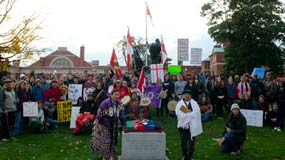To most people, climate change is old news. It’s very clear that our planet is warming, that our weather systems are changing to become more erratic (including increased droughts, hurricanes, and floods), and the impacts on human life are expected to be catastrophic if action is not taken immediately to address these threats.
However, the Canadian government continues to obstruct both international and grassroots action on climate change and its causes, preferring to abandon the Kyoto Protocol, deregulate and de-fund environmental oversight bodies, as well as subsidize and promote the fossil fuel industry, touting the Tar Sands and its related pipelines as Canada’s great economic hope.
In light of this, from October 26 to 29 nearly 1500 people – most of them youth – from across the country came together in Ottawa for a Climate Justice Conference called Power Shift, to build momentum around the movement to stop climate change and fight for a sustainable future on a healthy, liveable planet.
From the Power Shift website: “Climate and environmental justice was the primary focus of Power Shift 2012. Beyond education, mobilization, and collective action, the gathering included in-depth discussions on the role of frontline and Indigenous communities, environmental racism, dependence on oil, economic inequalities that stem from the extractive and carbon industries, as well as solutions to these crises such as food sovereignty, renewable energy, and public transportation.”
With over a hundred different workshops, panels and skill-building sessions crammed into two days, as well as keynote speeches from such environmental and social justice leaders as Winona LaDuke, Bill McKibben, Naomi Klein and Clayton Thomas-Muller, Power Shift was an opportunity for participants to learn more about the need for a climate justice movement, to find inspiration and to build skills to take back to their communities and work to that end.
Throughout the weekend, we heard from several members of frontline Indigenous communities, who have been living with – and resisting – the systematic destruction of their lands as corporations seek diamonds, timber, oil, bitumen (also called Tar Sands) and natural gas in their territories, against the wishes of these communities who continue to live in poverty.
Crystal Lameman gave a passionate keynote address describing the effects of the Tar Sands on her community, the Beaver Lake Cree First Nation, which is suffering from endemic poverty, high unemployment, rampant health problems, and the destruction of their Indigenous identity and way of life.
Due to the presence of hundreds of thousands of oil wells, pipelines and other infrastructure segmenting the landscape of her traditional territory, the inherent rights guaranteed to Indigenous people in the Canadian Constitution – such as hunting and fishing rights or right to free, prior and informed consent about any development or resource extraction – are being eroded or ignored.
This story of the Canadian government’s denial of Indigenous peoples’ rights in the pursuit of resource extraction, and the social and environmental consequences of this, was echoed by numerous other speakers throughout the weekend.
Kiera-Dawn Kolson, an Indigenous woman from the Denendeh Nation in the Northwest Territories, explained that a diamond mine extracts $11 million worth of diamonds every day from their land. As corporations enrich themselves, her culture and her people are experiencing what she called “industrial genocide,” lacking basic access to clean water that most other Canadians take for granted.
This story is common to Canada’s First Nation communities: poverty, polluted soil and water, and extreme health problems abound even as they watch millions of dollars in diamonds, oil and other resources continue to be extracted from their lands; resource extraction which is inextricably linked to climate change.
Kierra-Dawn implored participants to see themselves as a part of the natural environment, speaking to the current tendency of our societies to see humans as separate from ecosystems. This was echoed by Winona LaDuke, who reminded conference-goers that, in Indigenous understandings, humans belong to the land, not the other way around, and that what we do to the land-polluting the air, water and soil-we do to ourselves.
As Bill McKibben pointed out in his keynote address “we are either going to break the power of the fossil fuel industry, or they are going to break the planet.”
The conference culminated on Monday with hundreds of people marching through the streets of the capital to demand an end to the 1.4 billion subsidization of the fossil fuel industry by the Canadian government.
Comprehensive, sustainable and grassroots solutions to environmental and social injustices contribute to ongoing movements, root us in our communities, address climate change and help to create elements of a better world.
To see video clips of some of the workshops and speakers from the weekend go to www.wearepowershift.ca.













.png)








.png)